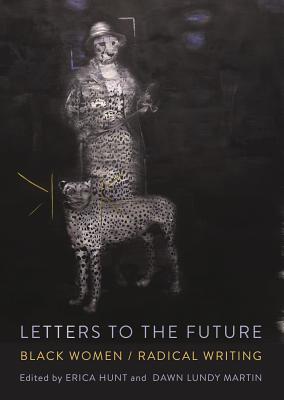2 Books Published by Kore Press on AALBC — Book Cover Collage
 Letters to the Future: Black Women/Radical Writing
Letters to the Future: Black Women/Radical Writing
by Erica HuntKore Press (Aug 17, 2018)
Read Detailed Book Description
Poetry. African & African American Studies. LGBTQIA Studies. Women’s Studies. Art. Edited by Erica Hunt and Dawn Lundy Martin. A collection of poems, essays, elder conversations, and visual works, LETTERS TO THE FUTURE: BLACK WOMEN / RADICAL WRITING, celebrates temporal, spatial, formal, and linguistically innovative literature. The anthology collects late-modern and contemporary work by Black women from the United States, England, Canada, and the Caribbean—work that challenges readers to participate in meaning making. Because one contextual framework for the collection is art as a form of epistemology, the writing in the anthology is the kind of work driven by the writer’s desire to radically present, uncovering what she knows and does not know, as well as critically addressing the future.
Erica Hunt, in her introduction to the collection, says, The future is a slippery project. What can it hold? We asked writers to write about it, imagining the future as the present conjugated—conjoining the past, the present with some other time…One dimension that drew our curiosity was to know how this particular group of Black women writers would respond to the question of tomorrow. The Black women in this edition were writers we’d known or been introduced to who had been insistent makers of poems and prose that set up radical encounters between language, person, community and the political. We discussed these letters as we received them, marveling at the range of strategies to refract, forecast or expand the penumbra of the present into the shifting and dim lit future.
In Dawn Lundy Martin’s introduction, she says, It has always been difficult for me to conceptualize what we call blackness in relation to human bodies, particularly myself as an indicator of the thing I don’t quite understand. It’s a strange predicament, and a worrying one…On the one hand, the claim of blackness need not be a claim. A black person in the world experiences themselves as black given the perception by others as to what black is. It is a (mis)recognition, always legible, often very slight in the adjustment of the face, a minor tick, a momentary widening of the eyes, almost imperceptible in its speechless announcement, ’a black is in the room.’
List of contributors includes Betsy Fagin, Ruth Ellen Kocher, Robin Coste Lewis, Lillian Yvonne Bertram, LaTasha N. Nevada Diggs, r. erica doyle, Adjua Gargi Nzinga Greaves, Duriel E. Harris, Harryette Mullen, giovanni singleton, Evie Shockley, Khadijah Queen, Wendy S. Walters, Adrian Piper, Yona Harvey, Harmony Holiday, Tracie Morris, Claudia Rankine, Deborah Richards, Metta S ma, Kara Walker, Renee Gladman, Tonya Foster, Julie Patton, Akilah Oliver, Simone White, M. NourbeSe Philip, Lucille Clifton and Sonia Sanchez in conversation, Wanda Coleman interview, Jayne Cortez and Sekou Siundiata with Tracie Morris, Erica Hunt, Dawn Lundy Martin, and Tisa Bryant.
 The Saving Work
The Saving Work
by Tiphanie YaniqueKore Press (Sep 10, 2007)
Read Detailed Book Description
Short story chapbook, laser printed and hand assembled with unique burn mark on cover. This is the first in a series of short fiction chapbooks published by Kore Press for the annual Kore Press Short Fiction Award.
An Excerpt from The Saving Work
A church is burning down. On a Caribbean island, in the countryside, up a road that might lead to a saving beach, but does not—a church is burning down. Everyone who is associated with this church will later think “my church has burnt down.” But for now there are only two women there to look at the fire, and blame each other.
They are both white American women in the middle of their lives. They and their families are members of this church. They are each married to a local black man, both of whom are skinny and frail of body. These women want to be the strong ones. They have always been the strong ones.
Deirdre Thompson has brought the garlands for the church stairs. She has brought the pew pins and the flowers for the altar. She was the first to arrive and see the bright flames. She is already dressed in her gold silk suit. She saw the smoke from far away in her car, but she imagined some filthy native was burning garbage in his yard. The smoke seemed to disappear as Deirdre drew near the church. This was an illusion.
Her car had lumbered its way along the narrow cut into the land that is the church road. The men of the church laid the road, and, as a result, it dips erratically. The arms of thin trees scraped at the closed windows of Deirdre’s car. She wondered why no one had cut them back. She thought, with some worry, about how the limousine would make its way. The road opened into the clearing where the church crackled in the center. Through the windshield Deirdre saw what she thought was just a smallish fire, more smoke than anything. Nothing to alert the people in the nearby houses, some two hundred yards beyond the bushes.
But now Deirdre knows what she’s seeing. She’s seeing the end.
